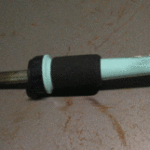If you are an electronics hobbyist or professional, at some point you will have to solder something. Many people are intimidated by soldering, partly because it is unfamiliar, and partly because they are scared of burning themselves on a soldering iron, which can reach temperatures higher than 400 degrees Celsius. This article will guide you through the process of creating a good solder joint with mechanical strength, electrical conductivity, and to do so safely and with a minimal chance of injury.
The first thing you will need to do when faced with the need to make an electrical solder connection is to decide how powerful of a soldering iron you will need. If you are soldering small electrical components or semiconductors such as transistors or diodes, you will want to get a smaller wattage soldering iron due to the potential to damage the components with too much heat. If the connection you need to make is primarily for mechanical strength in addition to electrical conductivity (say, to build a ham radio antenna), then you will want a higher wattage soldering iron or even a soldering gun. For bulkier projects, a hotter iron is needed to guarantee that the solder remains in a liquid state long enough for the solder to flow to cover the desired area. After you choose the proper instrument, you will need some basic safety gear such as eye goggles and gloves (so you do not accidentally burn your hands), a moist sponge with which to clean the soldering iron’s tip, and a vice or something similar to hold the job steady while you solder. Finally, you will need to choose the solder. A basic solder composed of tin and lead will be suitable for most jobs, while fine soldering jobs may call for silver solder that has silver added to the solder alloy. The gauge of solder required will also depend on the job to be done, with smaller diameter solder being used for finer jobs and larger diameter solder being used for larger, bulkier jobs.
The first step in soldering is to heat up the iron. The iron should be good and hot before soldering to avoid a cold solder joint. A cold solder joint will lack mechanical strength and often will result in a poor electrical contact. A hot enough iron is the solution to this problem, although you must be careful not to cause heat damage to the components you are working with. Next you should “tin” the iron by applying a small amount of solder to the hot iron’s tip. This will serve to rinse the iron of corrosion and allow the solder to flow freely from the iron’s tip onto the job you are working on. After tinning the iron, quickly wipe any excess solder from the tip onto the moist sponge. Now you are ready to solder.
The first step to to place the components to be soldered into their final position. This may entail inserting the component’s wire leads into a printed circuit board to twisting wires together for a mechanical connection. The process will vary depending on what materials you are soldering. You should ensure that the components are firmly in place and cannot be easily moved so that the solder can dry without being moved once the solder is applied. The nest step is to heat up the component’s leads with the iron before applying the solder. The materials themselves must be hot so that the solder can bond to the metal without creating a cold solder joint. Again, be careful not to overheat any delicate materials. If you are concerned about this, or if you are dealing with semiconductors, you may apply a heat sink between the area to be soldered and the components themselves. This will serve to divert the heat away from the component and onto the heat sink and functionally protect the components from damage.
Once the materials to be soldered are adequately hot (usually a few seconds into the process or longer for larger jobs), apply solder to the junction of the iron and the materials to be soldered. The solder should flow freely onto the materials at this point. You must be careful not to use too much solder and accidentally create a short circuit with nearby components or metals, and you must use enough solder to make a strong connection. This balance usually just takes practice to find.
Once the solder has been applied, gently remove the iron from the materials and allow the solder connection to dry. It is important that the solder joint remain immobile during the drying/cooling process. If the joint is accidentally moved, the cooling solder may crack and reduce the strength of the mechanical and/or electrical connection. Do not quicken the cooling process artificially by blowing on the joint. This also will cause the solder to crack and warp and cause a less than perfect solder joint.
After the solder joint is made, if you need to repeat the process again to make another joint, just re-tin the soldering iron or gun and follow the same procedure. It is important to work slowly, though, so that you make good solid solder joints and do not accidentally injure yourself. If you get impatient you may accidentally flick hot solder off the iron and burn yourself or others; hence the importance of eye wear. Hot solder blobs and unprotected eyes do not mix! If you follow these basic guidelines, you will be able to make a solid solder connection that should last for many years.






